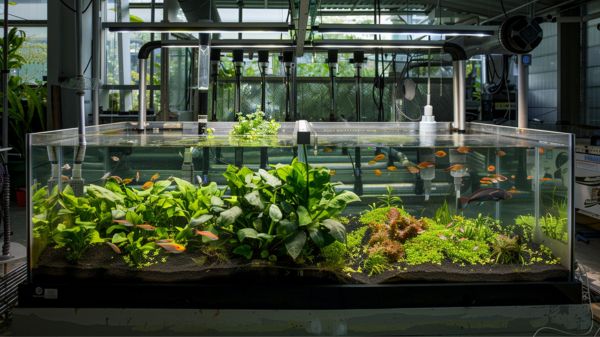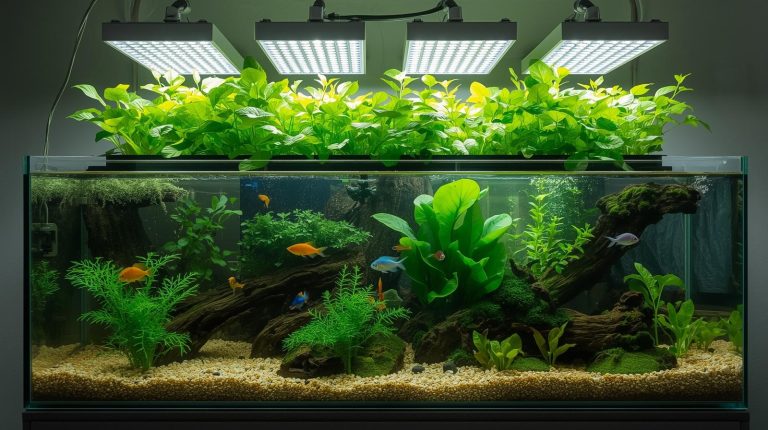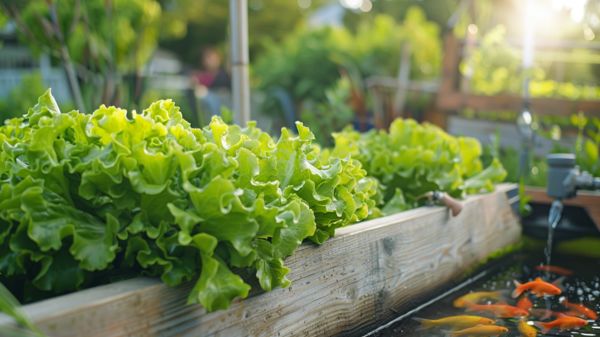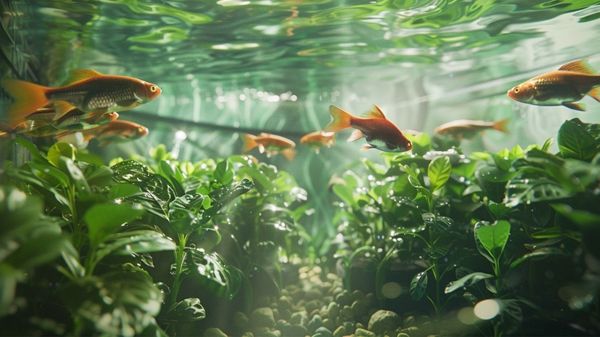If you’ve ever wondered how to transform a simple fish tank into a thriving aquaponics system, you’re in for a treat. Discover how five straightforward steps of a DIY aquaponics fish tank that can lead you to a self-sustaining ecosystem that benefits both aquatic life and plants.
Starting with the basics of component selection, this methodical guide eases you into the world of aquaponics with precision and clarity. By the end, you’ll be equipped with the knowledge needed to embark on a fulfilling journey towards sustainable living.

Key Takeaways
- Choose appropriate fish and plant species for your DIY aquaponics system.
- Build a safe and durable fish tank using suitable materials.
- Cycle your system efficiently to establish a balanced environment.
- Maintain water quality, monitor fish health, and harvest plants regularly.
Planning Your Aquaponics System
To effectively plan your aquaponics system, begin by assessing the available space and your desired output to determine the appropriate size and scale required. Consider integrating fish species like tilapia, catfish, or trout that are well-suited for aquaponics.
For plants, opt for leafy greens, herbs, and tomatoes as they thrive in aquaponic environments. Ensure the location chosen for your system receives adequate sunlight exposure for optimal plant growth. Additionally, plan for scalability from the outset to accommodate future expansions as you gain experience in managing your DIY aquaponics setup.
When deciding on the size of your aquaponics system, factor in the space available for both the fish tank and the plant grow beds. Tilapia, known for their resilience and rapid growth, are popular choices for beginners due to their suitability for aquaponics.
Leafy greens such as lettuce and kale, along with herbs like basil and mint, are excellent options for your plant selection. Tomatoes, which require a bit more attention, can also thrive in aquaponic systems given the right conditions. Remember, a well-thought-out plan tailored to your space and goals is key to the success of your aquaponics venture.
Related Post: 7 Best Aquaponic Betta Fish Tanks for a Beautiful and Sustainable Home Aquarium.
Building the Aquaponics System
Assess the suitable fish tank size based on your planned aquaponics system scale, ensuring the material’s safety for aquatic life and durability for long-term use. Choose a tank that provides ample space for your fish while considering the system’s overall size.
Opt for materials like food-grade polyethylene or fiberglass, which are safe for aquatic life and resistant to corrosion. Place the fish tank in a location with access to natural light or install appropriate artificial lighting to support plant growth.
Integrate a water pump and plumbing system to facilitate water circulation between the fish tank and grow bed, promoting nutrient distribution. Before introducing fish and plants, thoroughly test the fish tank for leaks and proper functionality to ensure the system’s success.
Prioritize aquatic life safety by selecting a durable material and an appropriate location for the fish tank within your aquaponics setup.
Cycling Your System
Establishing a healthy aquaponics system begins with cycling, a crucial process that kickstarts the nitrogen cycle by introducing beneficial bacteria to convert toxic ammonia into nitrate for plant uptake. Cycling typically spans 2-6 weeks, requiring diligent monitoring of water parameters such as ammonia, nitrite, and nitrate levels.
To initiate the cycling process, introduce ammonia sources like fish food or pure ammonia, which help build up beneficial bacteria colonies. Regularly testing water and observing bacterial growth are essential in this phase to create a stable environment for your aquaponics system.
The presence of beneficial bacteria is pivotal as they play a key role in breaking down ammonia, ultimately forming nitrate, which is vital for plant growth. By focusing on nurturing these beneficial bacteria colonies and maintaining optimal water conditions, you pave the way for a thriving aquaponics ecosystem that benefits both your fish and plants.
Introducing Fish and Plants
When introducing fish and plants into your aquaponics system, ensure that you carefully select species that are compatible with your system’s size and environmental conditions.
Consider fish species like tilapia, catfish, or goldfish, taking into account the water temperature requirements and the size of your aquaponics setup. Similarly, choose plants such as lettuce, herbs, or tomatoes that thrive in aquaponic environments and can benefit from the nutrients present in fish waste.
To establish a balanced ecosystem, introduce fish gradually to allow them to acclimate to their new surroundings and minimize stress. Plant seeds or seedlings in the grow bed, providing a suitable environment for the plants to grow and utilize the nutrients derived from fish waste.
Monitoring fish behavior, plant growth, water quality, pH levels, and nutrient levels is crucial to maintaining the health of both fish and plants while ensuring a proper balance in your aquaponics system.
Maintain a close eye on the fish to plant ratio, as it directly impacts the overall well-being of your aquaponics system. Regularly check monitoring systems to uphold water quality and adjust parameters as needed to create an optimal environment for both fish health and plant growth.
Maintaining Your Aquaponics System
To ensure the longevity and success of your aquaponics system, meticulous attention to maintaining water parameters, monitoring fish health, and performing routine cleaning tasks is imperative.
- Regularly check and adjust pH levels, ammonia, nitrite, and nitrate levels to maintain system health.
- Monitor fish behavior closely for any signs of stress or illness that could affect the ecosystem.
- Implement a consistent cleaning and maintenance schedule to prevent algae growth and ensure optimal system functionality.
- Harvest mature plants and prune them regularly to promote continuous growth and maintain a balanced environment.
In the event of any issues, promptly troubleshoot, adjust feeding schedules, and seek expert advice if problems persist in your aquaponics system. By staying proactive in managing these aspects, you can enjoy a thriving aquaponics setup that provides both a bountiful harvest and a harmonious habitat for your fish and plants.
Frequently Asked Questions
How Do You Make an Aquaponics System Step by Step?
To make an aquaponics system step by step, you need to carefully plan water filtration, plant selection, nutrient cycling, system maintenance, fish stocking, grow bed setup, pH balance, water testing, lighting requirements, and pest control for optimal results.
What Five Things Are Needed to Start an Aquaponics System?
To start an aquaponics system, you need a fish tank, grow beds, water pumps, plumbing components, and beneficial bacteria. These essentials work together to maintain water quality, nutrient cycling, and overall system functionality for successful plant growth and fish health.
How Do I Turn My Fish Tank Into an Aquaponics System?
To turn your fish tank into an aquaponics system, consider the connection between fish health, plant growth, and water quality. Proper tank setup, system maintenance, and nutrient cycling are vital for aquaponics benefits. Avoid beginner mistakes and DIY challenges while harvesting produce efficiently.
What Is the Best Aquaponic System for Beginners?
For beginners, a recommended aquaponic system involves a small fish tank and grow bed. Select hardy fish like tilapia, grow leafy greens and herbs, maintain system balance through regular water testing, adjust nutrient levels, ensure proper grow bed size, provide adequate lighting, choose suitable pumps, control pests, and regulate temperatures.

Conclusion
By following the 5 steps outlined in this guide, you can successfully create your own DIY aquaponics fish tank system. Remember to plan carefully, build efficiently, cycle effectively, and maintain diligently to ensure the health and productivity of your fish and plants.
With dedication and attention to detail, you can enjoy the benefits of aquaponics as a sustainable and rewarding hobby or food production method. Happy aquaponic gardening!




